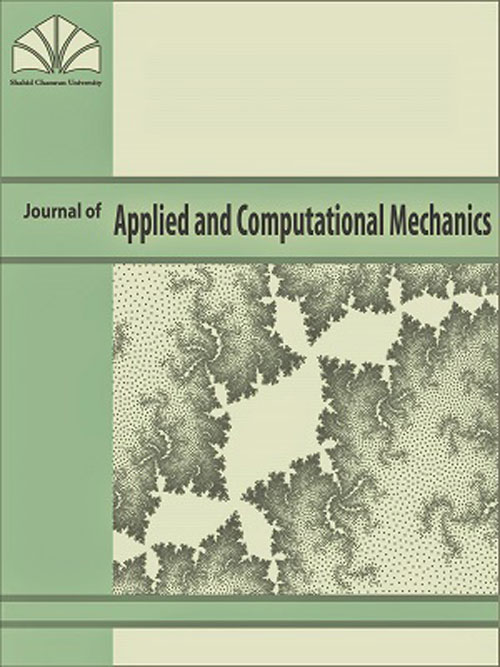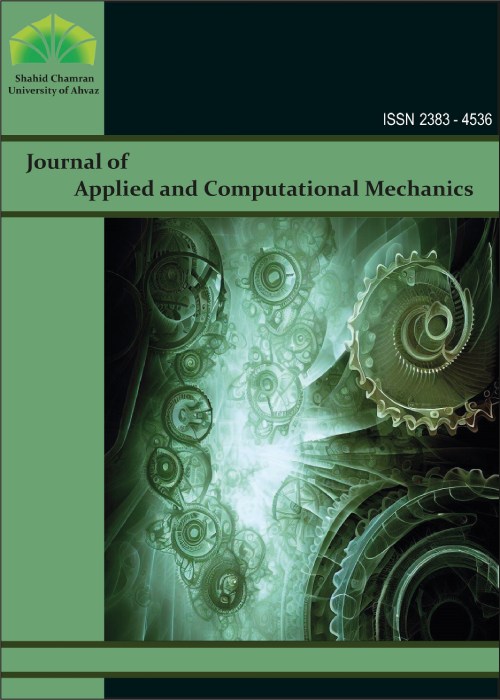فهرست مطالب

Journal of Applied and Computational Mechanics
Volume:1 Issue: 3, Summer 2015
- تاریخ انتشار: 1394/06/30
- تعداد عناوین: 6
-
-
Pages 112-121This paper presents a nonlinear model of a clamped-clamped microbeam actuated by an electrostatic load with stretching and thermoelastic effects. The frequency of free vibration is calculated by discretization based on the Differential Quadrature (DQ) Method. The frequency is a complex value due to the thermoelastic effect that dissipates energy. By separating the real and imaginary parts of frequency, the quality factor of thermoelastic damping is calculated. Both the stretching and thermoelastic effects are validated by the referenced papers. This paper shows that the main nonlinearity of this model is voltage, which makes the difference between linear and nonlinear models. The variation of thermoelastic damping (TED) versus geometrical parameters, such as thickness, gap distance and length, is investigated and these results are compared by linear and nonlinear models in high voltages. This paper also shows that in high voltages the linear model has a large margin of error for calculating thermoelastic damping (TED) and thus the nonlinear model should be used.Keywords: thermoelastic damping, stretching effect, resonator, differential quadrature method
-
Pages 122-133In this article, finite difference method (FDM) is used to study the size-dependent free vibration characteristics of rectangular nanoplates considering the surface stress effects. To include the surface effects in the equations, Gurtin-Murdoch continuum elasticity approach has been employed. The effects of surface properties including the surface elasticity, surface residual stress and surface mass density are considered to be the main causes for size-dependent behavior that arise from the increase in surface-to-volume ratios at smaller scales. Numerical results are presented to demonstrate the difference between the natural frequency obtained by considering the surface effects and that obtained without considering surface properties. It is observed that the effects of surface properties tend to diminish in thicker nanoplates, and vice versa.Keywords: free vibration, surface effects, size, dependent, rectangular nanoplate, finite difference method
-
Pages 134-144In this paper, the synchronization of a new hyperchaotic complex system based on T-S fuzzy model is proposed. First, the considered hyperchaotic system is represented by T-S fuzzy model equivalently. Then, by using the parallel distributed compensation (PDC) method and by applying linear system theory and exact linearization (EL) technique, a fuzzy controller is designed to realize the synchronization. Finally, simulation results are carried out to demonstrate the performance of our proposed control scheme, and also the robustness of the designed fuzzy controller to uncertainties.Keywords: a new hyperchaotic complex system, hyperchaotic synchronization, T, S fuzzy model, parallel distributed compensation (PDC) method, exact linearization (EL)
-
Pages 145-151Adhesion level for the proper running of rail wheelset on track has remained a significant problem for researchers in detecting slippage to avoid accidents. In this paper, the slippage of rail wheels has been observed applying forward and lateral motions to slip velocity and torsion motion. The longitudinal and lateral forces behavior is watched with respect to traction force to note correlation based on the angle of attack. The deriving torque relation with tractive torque is watched to check slippage. Coulombs law is applied in terms of tangential forces to normal forces owing to creep co-efficient and friction to get the adhesion. Nadals limiting ratio is applied to escape from wheel climb and derailment from track depending upon wheel profile and flange on straight path and curves.Keywords: Traction, Torsion, creep forces, angle of contact, creep co, efficient, friction
-
Pages 152-160In the present paper, the aeroelastic stability of helicopter rotor blade is determined using Aeroelastic Frequency Response Function. The conventional methods of aeroelastic stability usually use an iterative procedure while the present method does not require such approach. Aeroelastic Frequency Response Functions are obtained by inverting dynamic stiffness matrix of the aeroelastic system. System response could be obtained through exciting each degree of freedom. The resulting response was then plotted and the behavior of this function was investigated to find out the stability criteria and system natural frequencies. The results of this method are compared with stability boundaries obtained from the conventional p-k method and it can be inferred that, compared to other methods, the present algorithm is of less numerical cost.Keywords: aeroelastic frequency response function, rotor blade, aeroelastic stability, critical pitch angle
-
Pages 161-167Springback is one of the most common and important issues in metal forming area. Due to the fact that springback depends on a variety of parameters, it is hard to predict. Hence, in this paper, the effect of continuum damage mechanics (CDM) on springback was investigated based on the Lemaitre isotropic unified damage law. Swifts hardening law was employed to describe isotropic hardening behavior. The results indicated that considering the damage mechanics concept in springback modeling increases the predictability of springback.Keywords: Springback prediction, Damage, Simulation, L, bending test, FEM


